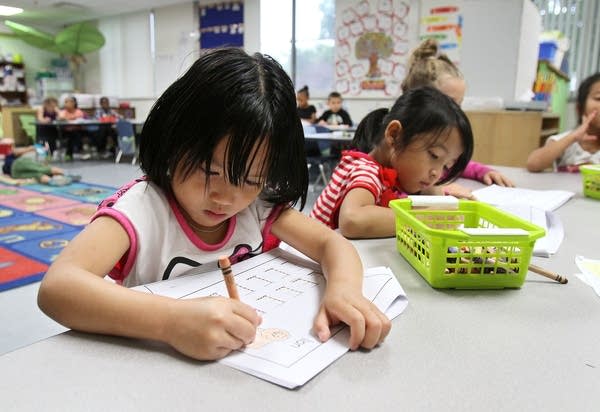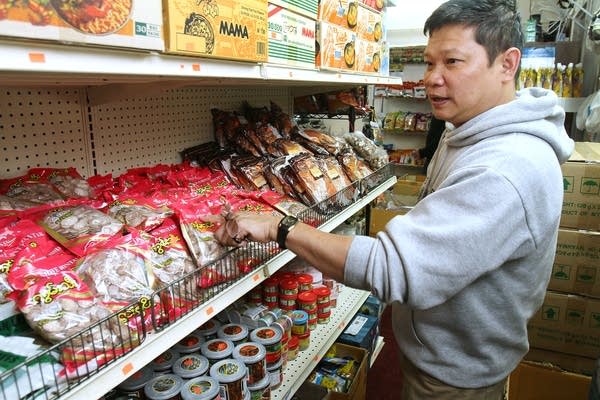Growing Karen population brings new round of changes to Austin, Minn.

Go Deeper.
Create an account or log in to save stories.
Like this?
Thanks for liking this story! We have added it to a list of your favorite stories.
As 5-year-olds Mi Meh and Paw Soe sit at a table, their little hands digging through a tray of crayons, they pick out pink and peach ones, and wait for Wendy Pedersen's instructions.
"We're doing the letter 'L' today," said Pederson, a teacher at Woodson Kindergarten Center. "L says 'ellll', 'ellll', 'elll'. Like lion... Remember after you do it, you say 'ell.'"
The two girls are among nearly 100 students in Austin Public Schools who arrived in the last year and whose families are Karen or Karenni refugees from Southeast Asia.
St. Paul is home to the largest Karen population in the country. But in recent years, Austin has attracted hundreds of the Karen and Karenni people.
Turn Up Your Support
MPR News helps you turn down the noise and build shared understanding. Turn up your support for this public resource and keep trusted journalism accessible to all.
Austin, a meatpacking town that has seen big demographic changes in the last few decades, started attracting workers from Mexico and Latin America in the early 1990s, followed by a wave of African immigrants.
The city's growing Karen population is the first influx of minorities that has not been Latino or African, and the change has come fast.
According to the city's Welcome Center, the number of Karen and Karenni residents in Austin nearly tripled to 1,224 this year, up from 463 in 2012. Driven out of their long-adopted home of Myanmar to camps in Thailand, the members of the two groups are flowing to the United States as refugees.
That means they can work legally, and some have replaced other immigrants at workplaces like Austin's Hormel and Quality Pork processing plants, Austin schools superintendent David Krenz said.

"We look more urban than we look rural. But we're still in rural Minnesota," Krenz said. "And it's not just here in Austin. If you look at Worthington, Willmar, you look at other communities who have job opportunities that are needing to be filled; you're seeing people come to those jobs, whether they're white, they're black [or] they're Asian. It doesn't matter."
Working with diverse communities is certainly not new for Austin school officials. About a quarter of the district's intermediate and high school students are minority; at the elementary school, about 50 percent are. To help bridge the gap between school personnel and the latest wave of newcomers, the district aims to hire its first Karen or Karenni school liaison.
Meanwhile, teachers are still learning about a culture that brings new experiences to the city's classrooms. Last year, for example, a teacher asked students what they thought about when they heard the word "forest," Krenz said.
While some children said "trees, sunlight, animals," he said, "one Karenni student talked about hiding, running away from the military 'that were pursing us, trying to kill us.'"
The challenge for teachers, Krenz said, is trying to determine how to recognize such experiences, incorporate them into lessons and understand "where each child comes from."

They've been able to seek help from the Welcome Center, a social service organization established in 2000.
"They're moving here and they're settling here at an accelerated pace," said Jake Vela, the center's executive director. "And in the first time in our 14 year history, this group has surpassed all others utilizing the services at the center."
Vela said hiring two case managers to work specifically with the Karen and Karenni community has helped speed up their assimilation to rural living.
One of them is K'Pru Gold. She moved to Austin from St. Paul last summer and spends her days helping families secure housing, find doctors, and enroll kids in school.

On a recent afternoon, Gold walks into one of two new Karen grocery stores, stocked with everything from canned lychee to curry pastes and giant bags of rice.
She said Karen families have moved from St. Paul, but also from as far as Iowa and North Carolina to be closer to relatives who arrived in Austin before them. The ease of small-town living has made Austin and other rural communities attractive destinations, she said.
"I feel like this is my home. I'm sure I'll be here for a long time, I think."
Gold knows of 15 Karen or Karenni families that have purchased homes in Austin in the last two years, and three others are set to close this month. She's decided to stay, too.
"I like Austin because since I came here, a lot of people are very nice to me," Gold said. "They try, you know, to welcome me. I feel like this is my home. I'm sure I'll be here for a long time, I think."


